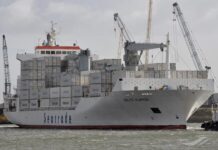
China Rail launched a sea-and-rail service on 8 June, to transport containers from Japan to landlocked Mongolia, via China’s Lianyungang port, 500km north of Shanghai.
The first train set off from Sino-Kazakh Logistics Cooperation Base (SKLCB) in Lianyungang in China’s Jiangsu province, carrying containers loaded with second-hand cars and construction materials, among other items. The containers had arrived by sea, from Japan, and will be railed to Ulan Bator, around 2,000km northwest of Lianyungang.
The Japan-China-Mongolia service is part of its Maritime Silk Route product, offering on-time deliveries through prescribed rail routes and shipping schedules.
State-owned China Rail already runs a number of container rail services between China and Europe, and in the wake of diminished air transport capacity amid the Covid-19 pandemic, there is demand for rail and sea transport.
China Rail said, “As a key part of the new channel between Asia and continental Europe, this rail-sea express line has achieved an effective connection between the innovation in the various ports’ Pilot Free Trade Zone and the demand for international trains.
“Our trains pass through Khorgos, Alashankou and Kashgar (all in the Xinjiang autonomous region) and the addition of Lianyungang has enhanced the Erenhot cross-border transportation channel, taking the land-sea combined transportation route to a new level.”
Coordinating with the service, Lianyungang’s customs office ensured fast and efficient clearance, effectively creating a “green channel” for containers.
China Rail said, “We want to offer direct shipping, with zero waiting time and this can shorten the transportation period by two to four days compared to conventional methods.”
SKLCB opened in May 2014, a year after President Xi Jinping unveiled the Belt and Road initiative, of which the Maritime Silk Route represents the seaborne aspect. Catering to international multimodal transportation, the facility has a 220,000m2 container yard and can handle 410,000TEU a year.
Martina Li
Asia Correspondent





